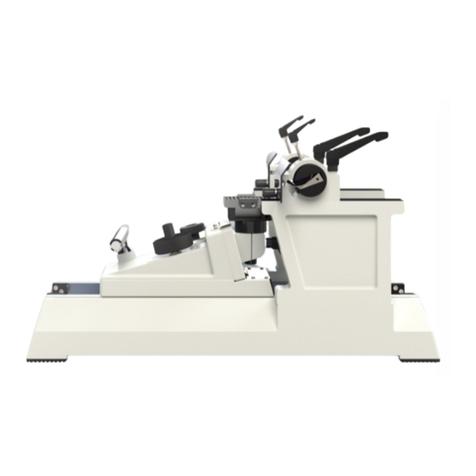
Bright Instruments 7
Care must be taken when using Cryospray
134. The risk of creating an aerosol of
potentially infectious tissue particles must be
borne in mind.
All communications should be direct to our
Quality Assurance Department and will be
acknowledged.
UV LIGHT POWER UNIT (WHEN SUPPLIED)
This switchable power output provides an
electrical supply for the optional UV light unit.
WARNING: The UV lamps emit short
wavelength UV (UVC) radiation, which is
potentially harmful to skin and eyes, and
therefore adequate safety precautions
must be taken.
It is a condition of the supply of this
option that you accept the responsibility
of ensuring that users are aware of
this situation.
OPERATION
When placing object holders in the microtome,
when orientating, manipulating or in any way
placing fingers in a position above the knife
edge – ensure that the hand wheel is locked
and knife guards are in position.
Parts of this instrument may attain
temperatures as low as minus 55ºC. It is
important to avoid allowing bare skin to touch
such cold surfaces – when in doubt, wear
gloves. Avoid touching the knife – it is cold as
well as sharp! ALWAYS use knife guards
ACCESSORIES
Fluids supplied as accessories with Bright
Instruments, such as Cryospray 134,
Cryo-M-Bed and microtome oil, are strictly
for laboratory use only. They should not be
taken by mouth and precautions afforded to
other laboratory chemicals should be adhered
to. Please refer to the material safety data
information.
DECONTAMINATION PROCEDURES
Cryostats & Ultra Low Temperature
Freezing Units: If decontamination is
required carry out the standard procedures
as practised in your laboratory. It is the
responsibility of the customer to use a
decontamination procedure appropriate to
his/her work. The following decontamination
method is as recommended in the ‘Code of
Practise for the Prevention of Infection in
Clinical Laboratories and Post-mortem Rooms’,
ISBN 0 11 320464 7.
a. Bring the cryostat to room temperature.
b. Place 50-100ml of formalin BP in a flat dish
inside the chamber. Close the window.
c. Leave for at least 24 hours, preferably
48 hours.
d. Open the window and place a beaker
containing 10ml of ammonia SG.880 in the
chamber. Close the window.
e. Leave for one hour. The cryostat is
now decontaminated.essential that it
be decontaminated.
Safety Information Cont.




























